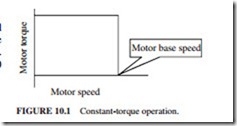BASIC PRINCIPLES OF AC VARIABLE-SPEED DRIVES
A variable-speed drive (VSD) is used to drive a motor at variable speed. The main parts of a VSD are
The control system of the VSD adjusts the output voltage and frequency so that the ratio of voltage to frequency remains constant at all times. The two modes of operation are as follows:
In this region, the motor increases in speed from zero to the rated base speed while the torque remains at the rated value (Fig. 10.1). The motor produces its maximum (rated) power at the base speed.
base speed (Fig. 10.2). The frequency of the VSD is increased and the flux is decreased while the armature voltage is kept at its rated value. Since the motor was at its maximum power at base speed, the torque must be reduced when the speed is increased (power torque X speed).
Related posts:
Hardware Bible - Functions and Components
Wiring Methods for Lighting Circuits:Definitions
Digital Logic:Integrated Circuits
Chapter 3
Light and associated radiation:Colour temperature
Solid-State Dc Drives:Voltage Control and Field Failure Control
POLE-CHANGING WITH SINGLE-PHASE SUPPLY INDUCTION MOTORS
AUDIO AND VIDEO SYSTEMS - ELECTRONIC MUSIC SYNTHESIZERS
Transformer:Short-Circuit or Impedance Test
Rules for Generating Direct Current
Calculators for Electricity and Electronics:Calculator requirements for electricity and electronics
Noise and Grounding:Class I and Class II
Hall effect sensors:Hall Generator Applications
Interfacing and Processing:Radio Frequency Filtration

